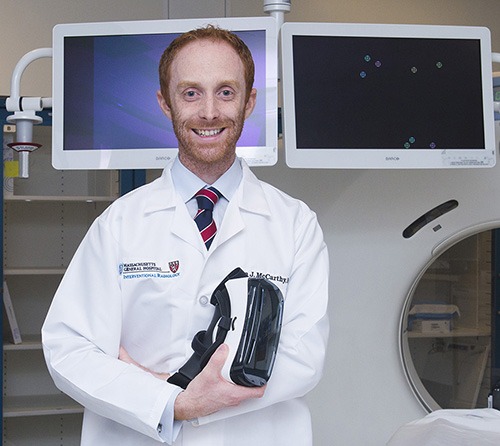
Whether you are chasing Pikachu in the park or planning an IR procedure, virtual reality is increasingly “part of life” and has huge opportunities in medical education, procedure planning, stroke rehabilitation and more, writes Colin McCarthy, Boston, USA.
Whether you have been walking through the mall, or flying over Google Earth, it is likely you have noticed a surge in interest related to virtual reality (VR) and augmented reality (AR) over the last few years. Although “virtual reality” headsets have been around for some time, recent advances in technology have revolutionised consumer-level head-mounted displays (HMDs).
Indeed, modern smartphones have sufficient processing power to allow users to experience virtual and augmented reality without any additional hardware, apart from perhaps a relatively cheap cardboard viewer.
The terminology surrounding virtual and augmented reality is worthy of a brief discussion. For many, the term “virtual reality” evokes images of a computer-generated world. However, it is now somewhat of a catch-all term for content, be it real-world or computer generated, that can be displayed in an immersive fashion using a headset or similar device. Immersive video content, or 360-degree video, refers to recordings of the real-world, where the viewer is able to control the viewing direction. Finally, augmented reality allows for computer-generated content to be overlayed on real world content.
There are many potential uses for the technology, ranging from gaming, to interior design and of course, healthcare. Early adopters of virtual reality and augmented reality in medicine have by now had a few years to develop applications and test potential uses of the technology.

At my hospital, we have been recording procedural content using a head-mounted 3D camera and an immersive 360-degree camera for several years. The footage is post-processed for display on a variety of devices, including head-mounted displays and smart phones, with the intention of delivering high quality content to junior trainees, for example. Medical students are another group that have already benefitted from this technology. A collaboration between Microsoft and researchers at Case Western Reserve University has resulted in the development of an impressive anatomy learning tool using the HoloLens.
Virtual reality technology also been used for other purposes, including stroke rehabilitation and pain management. Several hospitals have also started recording their facilities using 360-degree video, allowing both adult and paediatric patients to “visit” ahead of time, which may help with the fear and anxiety associated with undergoing a trip to the hospital.
Elsewhere, the technology is being used to assist with surgical planning. For example, Surgical Theater LLC has developed a platform that can be used to assist with neurosurgical planning, and may also be incorporated into the operating room workflow. This same technology could also offer patients a new perspective on their medical care, by allowing them to experience customised immersive content and facilitate shared decision making, for example.
It is certain that this type of technology could also help an interventional radiologist in preprocedural planning, too. Of particular interest for an interventional radiologist would be the ability to use augmented reality to overlay a DICOM image over a patient undergoing a procedure. Various image fusion applications and navigational tools have been developed over the years, and augmented reality would seem to be a natural extension. However, there are challenges associated with accurate image registration, soft tissue deformation and usability that will keep developers busy for some time to come.
Finally, augmented reality headsets may allow another method of information delivery to medical staff at the point of care. Being able to review laboratory results, imaging studies and other clinical data in real time at the bedside or in the interventional radiology suite certainly sounds appealing, but is not without challenges. In the era of “information overload”, it is possible that using the technology for this purpose would actually be counterproductive, and may serve as more of a distraction than anything else. Similar concerns have been raised with the use of heads-up displays in cars.
As sales of virtual and augmented reality devices continue to rise, so too will the number of potential uses for the technology in interventional radiology. There is no off-the-shelf solution that is easily deployable in a complex environment such as healthcare; separating hype from the potential tangible benefits to patients and physicians will take several more years. Continued research and refinement will maximise the potential for virtual reality and augmented reality in interventional radiology.
Colin McCarthy is an interventional radiologist at Massachusetts General Hospital in Boston, USA. He has reported no relevant disclosures pertaining to this article.













